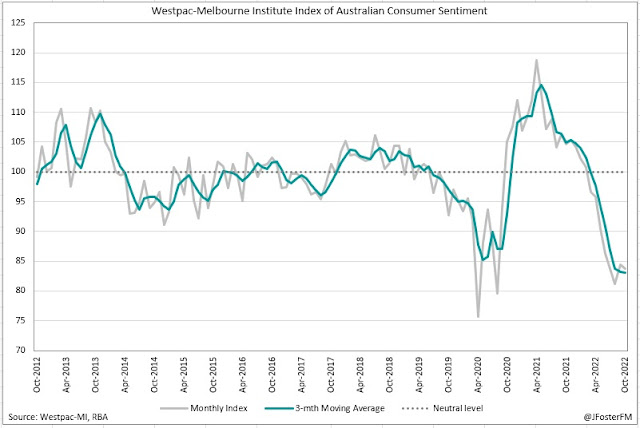The RBA slowed the pace of its tightening cycle to a 25bps hike in October following four consecutive increases of 50bps between June and September, coming after the initial hike in May (25bps). Although last week's CPI report is likely to prompt the RBA to raise its inflation forecasts in its quarterly Statement on Monetary Policy (due Friday), markets do not expect a reversal of the October pivot and are priced for a 25bps hike to bring the cash rate target to 2.85% and the Exchange Settlement rate to 2.75% (decision due at 2:30PM AEDT). Later on in the evening, Governor Philip Lowe is scheduled to speak (7:20PM AEDT).
Monetary policy decision
At the September and October meetings, the Board debated hiking by 25 or 50bps with the arguments coming out in favour of the former at the most recent meeting. The same discussion will likely take place today. Markets are priced for 25bps, but after headline and underlying inflation surprised to the topside in Q3, the risk is that the outcome could be 50bps. The RBA continues to state it will calibrate the "size and timing" of rate hikes to the inflation and labour market data.
Given the expectation is for 25bps, a 50bps hike if it were to eventuate would be seen as a major U-turn from the Board so soon after its October pivot. The RBA would object to that characterisation, but unless there has been a material reassessment of the inflation outlook that requires more frontloaded hikes, then hiking by 50bps today seems problematic to communicate and is ultimately unlikely to make much difference to bringing down inflation if it then slows back to a 25bps hike in December.
The main arguments behind the October downshift: waiting on the lagged transmission from the earlier hikes into the economy and an overarching judgement to move more slowly on hikes given the uncertainty of the global and domestic outlook, all still hold. The other point the RBA has emphasised is that its higher frequency of meetings affords it more flexibility to adjust the pace of hiking relative to other central banks still delivering outsized hikes.
Economic forecasts
The RBA's updated economic and inflation forecasts won't be published until the monetary policy statement is released on Friday, but they will be tabled to the Board for today's meeting. Governor Lowe will likely provide an overview of the main changes in today's decision statement and in tonight's speech. Upside risks to inflation and downside risks to growth are likely to be the main themes.
Factors that will put pressure on the Australian growth outlook are the deteriorating global backdrop and rising cost-of-living pressures at home. Modest downgrades to the growth outlook in 2022 (3.2%) and 2023 (1.8%) shape as likely outcomes. For inflation, Q3's outturns for headline CPI at 7.3%Y/Y and 6.1%Y/Y for the trimmed mean (or underlying rate) are likely to see the forecasts for their respective peaks later in the year pushing higher. Accordingly, the peak for headline CPI may be raised to above 8% (from 7¾%) and to around 6.5% trimmed mean (from 6%).
Summary
My view is in alignment with market pricing for the cash rate target to be hiked by 25bps to 2.85%, though 50bps is a risk. The key is the degree to which the RBA's inflation outlook has changed since the October meeting following the Q3 CPI data. Although some upward revision here is likely, I see the case for the RBA to continue to hike in 25bps increments.









































